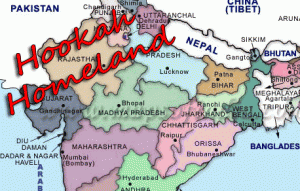The origins of the hookah come from the north western provinces of India along the border of Pakistan in Rajasthan and Gujarat. Originally designed to smoke opium and hashish (which has created a negative stigma for the modern hookah) the first hookah models were simple, rugged, and usually made from a coconut shell base. The term hookah comes from the ancient Indian word hukkah, or coconut.
Of course the terminology for these water pipes has evolved over many years and many regions. In the West, the pipe itself is referred to as the hookah while the word shisha is  applied to the flavored tobacco one would smoke out of it. In the Middle East, Eurasia, and South Asia the pipe itself is referred to as the Shisha, while the hookah tobacco is called Mu’assl, or Moassal, amongst others. Other references for the pipe span by region; in Turkey, they smoke from a Nargile, in Iran it is a Ghalyun, while in Syria one would order a Narguileh.
applied to the flavored tobacco one would smoke out of it. In the Middle East, Eurasia, and South Asia the pipe itself is referred to as the Shisha, while the hookah tobacco is called Mu’assl, or Moassal, amongst others. Other references for the pipe span by region; in Turkey, they smoke from a Nargile, in Iran it is a Ghalyun, while in Syria one would order a Narguileh.
When the hookah made its way into Turkey and Persia, it endured a surge of popularity among the upper class and intellectuals, causing a change in design and use. It was no longer simply for drug fiends, it was now being used for Tombeik (a traditional tobacco that is still used today), which is rinsed and packed in a large head (bowl), then hot coals are applied directly to the wet tobacco. The popularity of the hookah dipped in the 19th century when cigarettes were made easily available; the hookah then became an in-home entertaining item used primarily by women.
The hookahs designed in the Persian Empire are still handcrafted from wood. In Turkey, they moved away from the wood design and used more brass and glass. Intricate paintings and mosaics were added for beauty and elegance. The popularity of these works of art expanded into coffee shops in Turk society, where a hookah bar waiter was treated similar to a chef because of the preparation for hookah smoking. The packing and moisture was a skill, and it was considered rude to touch the coals. Today, hookah bars are often regarded as a community gathering place. In many Middle Eastern regions, hookah bars are for men only, and in some Muslim countries, smoking is thought to be a forbidden act (for example, the recent smoking ban in Saudi Arabia).
Most hookah smoking countries serve Naklia shisha. Naklia shisha is a combination of foreign tobaccos, honey molasses, and dried fruit. The smoke is filtered through ice cold water to make the smoke cool and soothing. Western society is slowly accepting the hookah as a pipe for tobacco instead of illegal drugs. The hookah has been growing in popularity in the United States, Japan, and Europe since the 60’s. As little as 10-15 years ago, hookah tobacco could only be found in Arabic grocery stores and specialty smoke shops, and the selection was very limited.
Today, thanks to the growing population of people of Eastern descent carrying this time-honored tradition over to the west ,including U.S., in the form of lounges, and by extending the hose to friends, hookah smoking is gaining popularity. At first glance, a group of friends puffing away at a tall water pipe may not seem that extraordinary. However, any regular partaker of the hookah will tell you that no hookah smoking session is the same. The art of preparing the hookah bowl, the sharing of techniques, the careful maintenance of the coals, the billowing smoke clouds, the friendly company – these are the elements that make hookah smoking a traditional pastime. Hookahs and shisha tobacco can be admired in the same way one would admire a fine wine; to many, there is no better expression of style and festivity than one experiences with friends, family, and hookah.
New to hookah, and still figuring out the basics? This video will help clarify the mechanics for you!
[youtube http://www.youtube.com/watch?v=vZk1Ig5uMlg&w=560&h=315]
